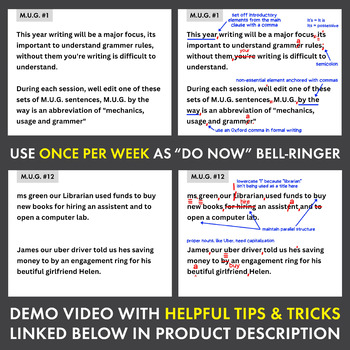Picture this: You walk into your eighth grade humanities classroom (or, maybe your middle/junior high school split social studies and English Language Arts into separate courses, making ELA more applicable here). Your backpack is slung over your shoulder and casually dropped onto the floor as you settle into your seat. It’s the classroom routine to start working on a “Do Now” prompt as soon as you get to class, but you notice there isn’t one written on the board. Then, you see it. Next to the first bullet of today’s agenda is the word “mugshot” printed in bold letters. Is today Picture Day? You look your outfit up and down in a panic, but soon your teacher enters and hands everyone a worksheet with a matching MUGshot title.
No, I am not trying to bring back the dreaded memories of middle school picture day, shining faces and gleaming braces included. I’m talking about a warm-up activity centered around Mechanics, Usage, and Grammar (a.k.a. MUGshots). In short, these activities ask students to correct a series of sentences that have several MUG mistakes, and each sentence is preceded with a list of MUG errors that can be found somewhere in the sentence. While the warm-up activity is simple to explain, easy to put together, and seamlessly incorporated into a humanities classroom routine, I was still a little nervous to start my take over of Team Nova’s humanities classroom by reintroducing some of my cooperating teacher’s old warm-up strategies. Nonetheless, Monday marked the first day of a so-far successful week where I have been guiding students through 2-3 MUGshot sentences a day.
Although I am positive I will have more thoughts and reflections on my warm-up activities throughout my student teaching semester, I wanted to use this post to talk about the differences I have noticed thus far between my three humanities classes and their engagement with the MUGshot activities.
At EMS, Team Nova eighth graders meet with their core subject teachers at the same time every day: one meeting early in the morning, one directly after lunch, and one falling between the middle core block and the forty-ish minute intervention time that concludes each day. For obvious reasons, afternoon core blocks tend to be the most lethargic in overall energy levels, which makes asking for volunteers to share their corrected sentences feel like pulling teeth. The last core block is also the smallest of my classes, and many of the students could be characterized as quiet. However, all of these students work through the warm-ups in a more efficient way than most students in the other core blocks: they manipulate the sentences directly rather than rewriting the sentence with corrections underneath the original text. In another core block, students volunteer their answers and support each other through corrections far more readily than the other two blocks, and the remaining core block students offer the most probing questions about the activity answers. While each core class has its different strengths, it is clear from just these first few days of reintroducing MUGshots that all Team Nova members are benefitting from the grammar practice. Already, student responses to the warm-ups are improving in accuracy all around, and I look forward to seeing students’ MUG skills progress as our Western Expansion unit moves into a diary writing mini-project. However, as nice as leading the classroom warm-ups has been this week, I am left wondering how I can improve these warm-ups in the weeks to come, especially since my core blocks all have different strengths and needs.
My initial thoughts on remedying the lack of enthusiasm for MUGshots in some core sections include introducing various types of grammar activities that are not strictly focused on MUG concepts, as well as incorporating warm-ups that are more creative in nature. One idea that comes to mind is offering students time to free write about a topic of their choice at the beginning of class, then asking them to trade their work with a partner for editing practice. I could also ask students to write in response to a prompt, highlighting specific parts of speech or MUG concepts that I want them to include in their writing structure. As my student teaching internship continues, I hope to better implement warm-up activities that my students can use to practice their writing skills, but I also wish to create engaging opportunities for students to connect with their learning and our classroom community before the day’s lesson begins.

Comments
Post a Comment